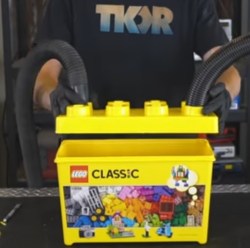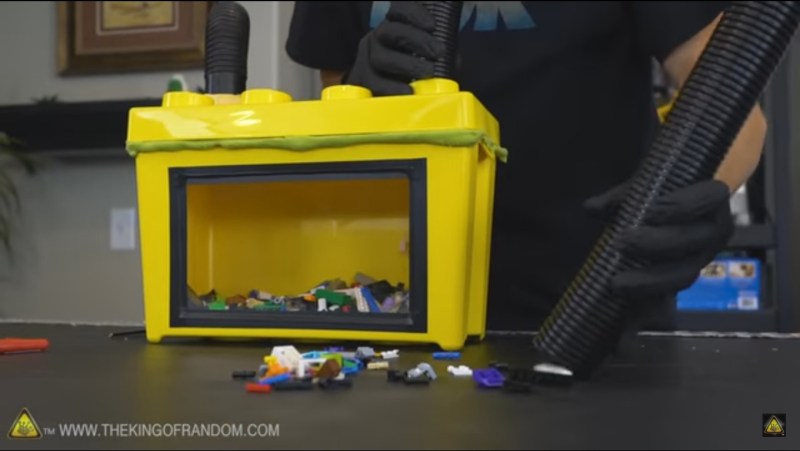The last chapter of the fourth book of the Hitch-Hiker’s Guide to the Galaxy trilogy mentions two hacks that made life pleasant enough to prevent a war: a super-fly that could fly out of the open half of a half-open window, and an off-switch for children. This is one of those types of hacks. Plus, it’s just an awesome idea, fun to watch, and possibly adaptable for the workshop.
 After the kids have gone to bed and LEGO bricks are scattered all over the floor, furniture, stairs (ouch), and everywhere else, wouldn’t it be nice if you could simply vacuum it all up directly into the LEGO box? This ingenious hack from [The King or Random] YouTube channel shows how to just that. They put two holes in opposite corners of the box’s lid, one a tight fit for a flexible intake hose and the other for the Shopvac hose, or a normal household vacuum cleaner hose if you prefer. A disk cut from flyscreen covers the Shopvac hole in case the suction is strong enough to pull the bricks back out of the box and into the Shopvac. They also make a gasket for the lid by mixing up some silicone sealant and cornstarch, the cornstarch is to prevent the cured mix from remaining sticky. We of course really like the version they made which has a window in the side of the box for watching the bricks as they fly in. Check out their build and the action in the video below.
After the kids have gone to bed and LEGO bricks are scattered all over the floor, furniture, stairs (ouch), and everywhere else, wouldn’t it be nice if you could simply vacuum it all up directly into the LEGO box? This ingenious hack from [The King or Random] YouTube channel shows how to just that. They put two holes in opposite corners of the box’s lid, one a tight fit for a flexible intake hose and the other for the Shopvac hose, or a normal household vacuum cleaner hose if you prefer. A disk cut from flyscreen covers the Shopvac hole in case the suction is strong enough to pull the bricks back out of the box and into the Shopvac. They also make a gasket for the lid by mixing up some silicone sealant and cornstarch, the cornstarch is to prevent the cured mix from remaining sticky. We of course really like the version they made which has a window in the side of the box for watching the bricks as they fly in. Check out their build and the action in the video below.
We wonder what other uses this can be put to. How about a container for sucking up a mess of loose hardware from a workbench or a garage floor for later sorting?
Where else can a vacuum come in handy? Here’s a vacuum table for holding down flexible material when using a laser cutter and another for holding parts on a CNC machine.
















nit picking here, but the cornstarch isn’t just to prevent the cured mix from remaining sticky. It also allows the silicone to cure quickly throughout. Without the cornstarch, the inside of any thick silicone blob or part may not cure at all, and if it does it can take days or weeks.
Also nit picking:
Silicone “dries” by reacting with water (vapor from air)
If you want thick slabs of silicone to dry quickly mix the corn starch or flour with a bit of water before mixing it with the silicone. This is sometimes done for making props instead of using 3 component silicone, which is harder to find and probably more expensive.
In this application the goal seems to be more to change it’s consistency.
Definitely nit picking:
Silicone, epoxy, polyurethanes (common floor finishes do both), and cyanoacrylates cure. Drying implies there’s some solvent evaporating or otherwise being removed, all of these polymerize through chemical reaction in a word: cure.
Exactly this. Alternatively, a two part silicone (platinum/tin) putty will do the same thing without needing this cornstarch stuff, but it’ll be more expensive. Most one part silicones (oxime/acetoxy/”caulk”) cure with a tiny bit of moisture – which is adsorbed onto cornstarch – and without that, deep sections of the silicone won’t cure quickly or at all because it’s too far from the humidity in the air.
It’s useful to know and IMO not really nit-picking, because mis-stating this sort of thing could make other people think one part silicone might work for casting straight up, even if you don’t want the putty consistency, and that would be a pretty huge disaster.
Cute! Good idea. Is there a way to prevent it sucking up too much dust? Because this thing is, after all, a vacuum.
Dust would continue its journey to the shop vac, and presumably get caught in the shop vac’s filter. The box and lego parts should actually stay pretty clean
It’s a good thing those LEGO pieces don’t stick together. Imagine how difficult it would be if the kid stuck maybe 4 or even 5 of those pieces together :O
We have a strict “no sticking together” rule for lego in our house. Lego should be seen, not adhered.
We used to put the LEGO pieces on an old bed sheet. When we were done, we’d draw up the four corners of the sheet, and drop the whole thing in a tote. Made for quick clean-up.
This is just genius.
And probably slightly younger than Lego Systems A/S. I’m all for exposing people to old tricks, but this is just that, an old trick.
where was this when i was a kid? it could have saved me many hours of picking up legos.
LEGO released a brick vac in 1991. Not a real vacuum but uses wheel to scoop pieces into compartment. Google LEGO 1666
Or try to be a parent and teach your kids to clean up after themselves. They might actually achieve something in life if you do.
Or even better, build this thing together with your kid and teach them to use it.
Neat. This would be awesome combined with an automatic sorter that flings different color LEGO into separate containers.